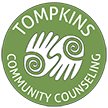What Sets Us Apart?
There are often many barriers to connecting with a therapist. Our goal is to break those barriers. That’s why we provide our services in a variety of alternative settings. During intake, we’ll talk about what your needs are, and we’ll link you to a licensed counselor who is a good fit for you.
Tompkins Community Counseling offers the following types of counseling:
Online Counseling (Tele-Health)
Community-based Counseling
Office-based counseling
Service dog ownership and support in session
FREE counseling for Veterans and their spouse
We’re Here For You.
Our office is located at 318 N. Aurora St, in the beautiful Fall Creek neighborhood of Downtown Ithaca.
Our Mission Statement: An Innovative Approach to Therapy
Here at Tompkins Community Counseling, we tailor to your needs and will work in the environment that is best for you. Our goal is to provide you with professional, client-led, goal-based counseling, while working in whatever setting is most comfortable for you— in the community, online, or in our office.
We understand how difficult it can be to ask for help and discuss your life challenges, so we try to make the journey as comfortable as possible for you. Simply put, we achieve this by following your lead throughout the counseling process. We use a Client-Led Counseling model, finding strengths that you already have and building on them to reach resolutions. We follow the pace of our clients to help them achieve control over their lives, helping them make positive choices by offering them specific tools and practical strategies for change. We also practice a wide variety of treatment models and support you in choosing one that is a good fit for you. We will help you to define your long term goals, allowing our sessions to be driven by focused goals that will lead to a successful discharge.
Meet Willie
Tompkins Community Counseling has a therapy dog to attend counseling sessions for clients that benefit from these services. Willie, our much-loved Goldendoodle, is trained to be attuned to emotions and provide the unconditional love and attention that a therapy dog can provide. We have found that children and clients who are processing traumatic issues benefit most from Willie.
We also offer our clients support in obtaining and training an Emotional Support Animal (ESA) or a Service Animal (SA).
Evidence-Based Counseling.
While the process of counseling is very individualized, the following is an outline of what you can expect during the counseling process.
Assessment: Establishing a relationship, identifying needs and stressors.
Goal Planning: Set goals and identify interventions to address concerns.
Intervention: Learn and practice evidence-based skills to meet goals.
Re-Assessment/Discharge: Evaluate goals and skills learned, identify outside supports.
Treatment Modalities Used
We will be working together during the second phase of treatment to identify which treatment modality will best meet your needs. Just because we pick a treatment modality, does not mean that it cannot change as your needs change. Below is a list of the main treatment modalities that we use, and a description of each modality.
Cognitive Behavioral Therapy, or CBT
Eye Movement Desensitization and Reprocessing Therapy or EMDR
Family Systems Therapy
Dialectical Behavior Therapy
Emotional-Freedom Technique




